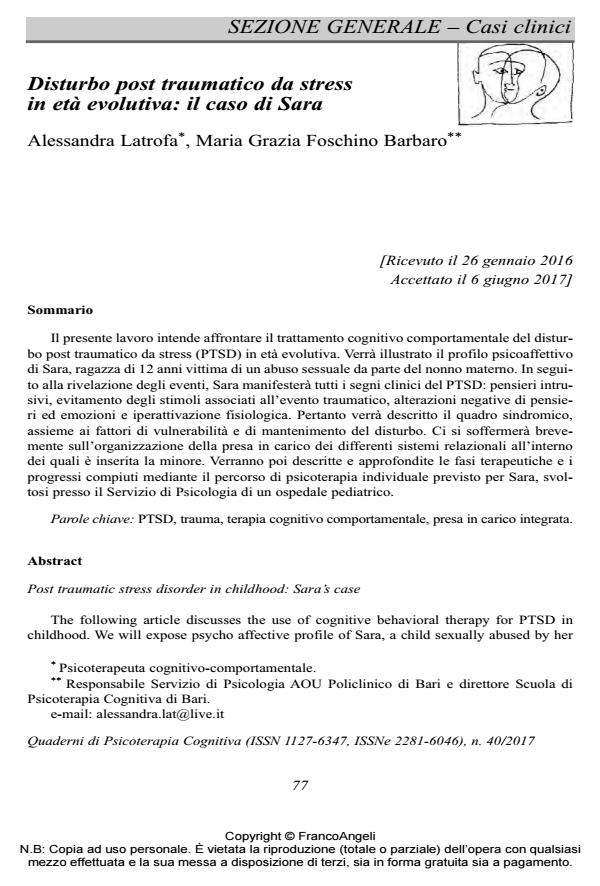Post traumatic stress disorder in childhood: Sara’s case
Journal title QUADERNI DI PSICOTERAPIA COGNITIVA
Author/s Alessandra Latrofa, Maria Grazia Foschino Barbaro
Publishing Year 2017 Issue 2017/40 Language Italian
Pages 12 P. 77-88 File size 96 KB
DOI 10.3280/QPC2017-040005
DOI is like a bar code for intellectual property: to have more infomation
click here
Below, you can see the article first page
If you want to buy this article in PDF format, you can do it, following the instructions to buy download credits

FrancoAngeli is member of Publishers International Linking Association, Inc (PILA), a not-for-profit association which run the CrossRef service enabling links to and from online scholarly content.
The following article discusses the use of cognitive behavioral therapy for PTSD in childhood. We will expose psycho affective profile of Sara, a child sexually abused by her grandfather. Following the revelation of the events, Sara will manifest all the clinical signs of PTSD: intrusive memories, avoidance, negative changes in thinking and mood, chances in physical reaction. Will be described the symptoms, vulnerability factors and maintenance of the disorder. Furthermore we will focus on the multiagency working of different relational systems within which is inserted the child and we will focus on the therapeutic steps of Sara, which was treated at the Psychological Service of a pediatric hospital.
Keywords: PTSD, trauma, cognitive behavioral therapy, multiagency working.
- Achenbach T.M. (1991). Manual for the Child Behavior Checklist=4–18 and 1991 Profile. Burlington: University of Vermont, Department of Psychiatry.
- American Psychiatric Association (2013). Diagnostic and statistical manual of mental disorders. Fifth edition. Washington D.C.: APA (trad. it.: Manuale diagnostic e statistico dei disturbi mentali, quinta edizione. Milano: Raffaello Cortina, 2014).
- Bronfenbrenner U. (1979). The ecology of human development. Cambridge, MA: Harvard University Press.
- Cianchetti C., Sannio Fancello G. (2001). Scale psichiatriche di Autosomministrazione per Fanciulli e Adolescenti SAFA. Firenze: O.S.
- Cohen J.A., Mannarino A.P. (2008). Trauma-Focused cognitive behavioural therapy for children and parents. Child and Adolescent Mental Health, 13(4): 158-162.
- Dettore D., Fuligni C. (2008). L’abuso sessuale sui minori. Valutazione e terapia delle vittime e dei responsabili. New York: McGraw-Hill.
- Di Pietro M. (1992). L’educazione razionale-emotiva [Rational-emotive education]. Trento: Edizioni Centro Studi Erikson.
- Liotti G., Farina B. (2011). Sviluppi traumatici. Eziopatogenesi, clinica e terapia della dimensione dissociativa. Milano: Raffaello Cortina.
- Porges S.W. (2011). The Polyvagal Theory: Neurophysiological Foundations of Emotions, Attachment, Communication, and Self-regulation (Norton Series on Interpersonal Neurobiology). New York: W.W. Norton & Company.
Alessandra Latrofa, Maria Grazia Foschino Barbaro, Disturbo post traumatico da stress in età evolutiva: il caso di Sara in "QUADERNI DI PSICOTERAPIA COGNITIVA" 40/2017, pp 77-88, DOI: 10.3280/QPC2017-040005